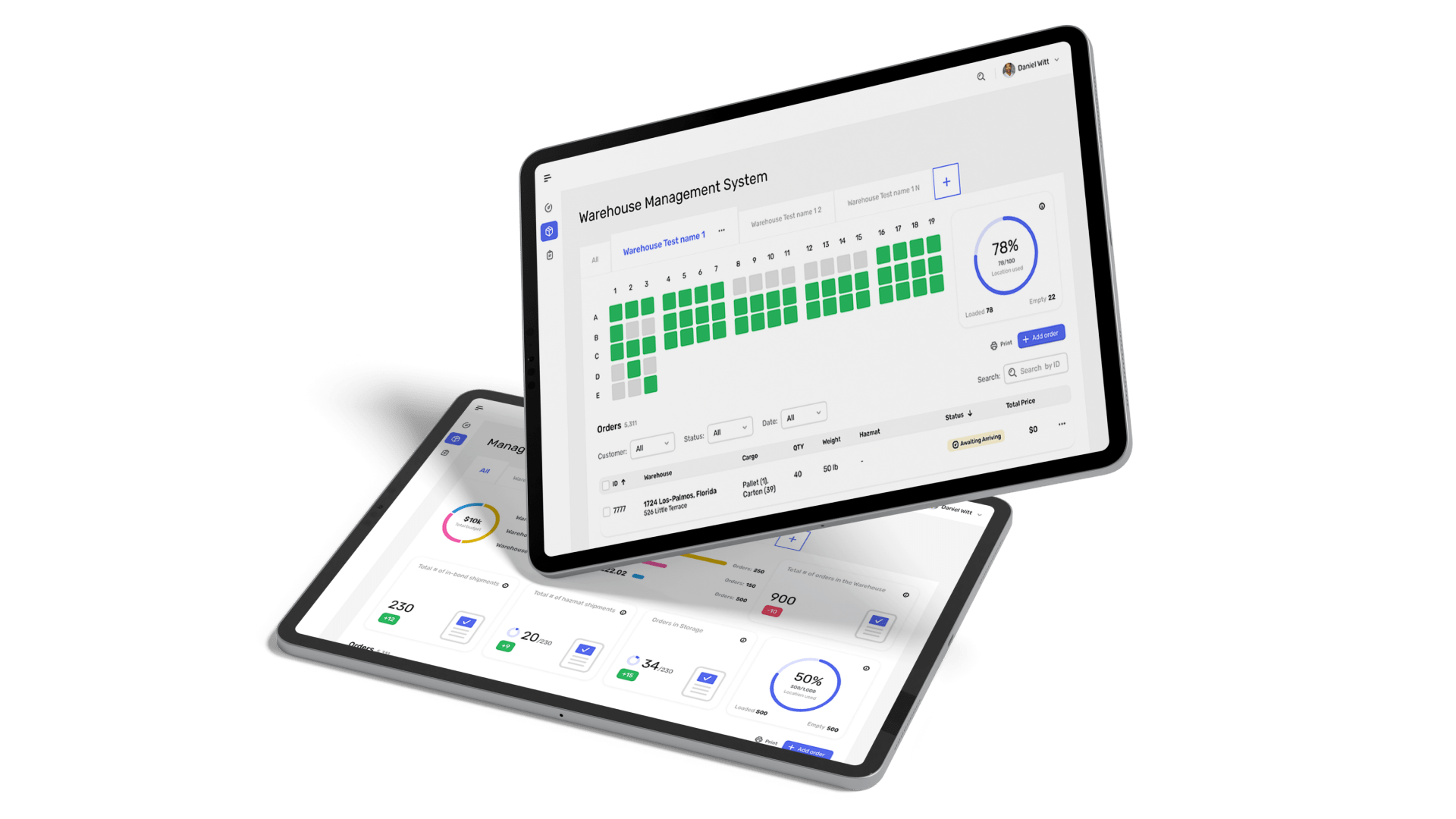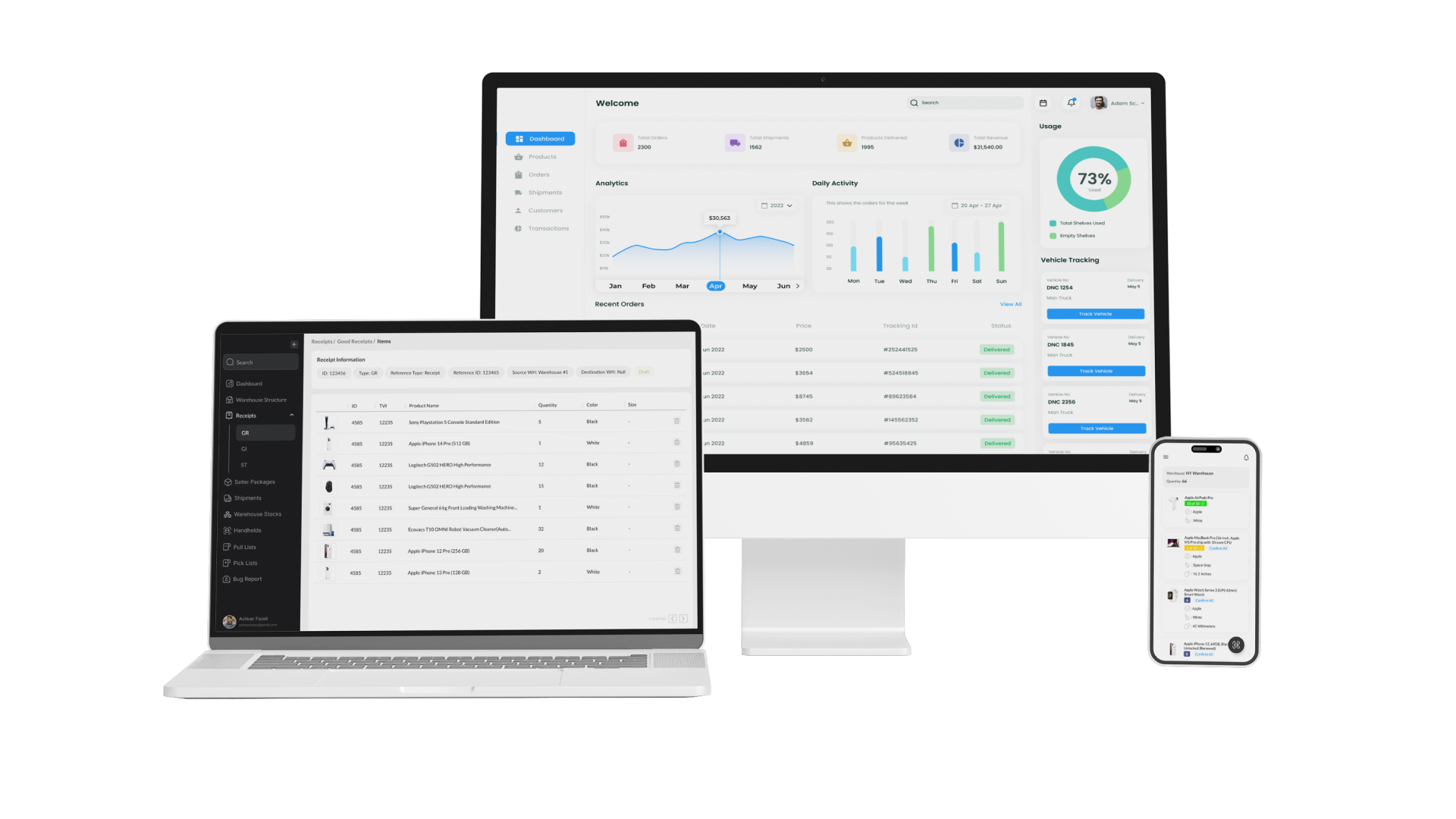Warehouse Management System, or WMS for short, is a comprehensive warehouse automation software. Such a system allows you to competently set up warehouse logistics, speed up the acceptance and delivery of goods, and also minimize the human resources necessary for the effective operation of the company.
In this article, we will take a closer look at what problems WMS solves and talk about how to implement such a system in your business.

At the software level, the WMS system consists of three parts:
WMS also uses various physical sensors, sensors, scanners, cameras and other devices. They read the necessary data and automatically transmit it to the server in real time. This allows you to significantly speed up warehouse operations.
For example, during acceptance, WMS can check the weight, contents and absence of defects of products, and then automatically put the goods on the company’s balance sheet. And most importantly, all these operations are performed without the participation of employees and almost instantly.

In short, WMS increases the transparency of processes and automates warehouse operations as much as possible. Ultimately, this has a positive effect on the quality of customer service, because the company begins to process orders much faster and deliver cargo on time. All this is possible thanks to the wide range of tasks that such systems can solve:
In addition, a WMS system minimizes the likelihood of human errors, since it automates most of the monotonous and routine tasks that employees previously had to perform.
Depending on the approach to data storage, there are three types of WMS systems – stand-alone, cloud and integrated:
It is also worth adding that WMS can be “boxed” and individual. The first option is more suitable for small companies, since in this case you will have to be content with only the limited functions that the software provider offers.
In turn, individual WMS are created taking into account the business logic and processes of a specific company. They are not only equipped with all the necessary functionality, but can also be modified at any time. Therefore, the relevance of such systems does not lose over time. This option is suitable for large companies with a developed warehouse infrastructure.

The choice of technology stack for WMS development is made taking into account the technical features and complexity of the software. For server-side development, Python/PHP programming languages and their frameworks are often used – Django/Flask/Yii2/Laravel. For the desktop version, C++/Java languages or the Node.JS platform can also be used. When choosing technologies for the client side, the deployment platform plays a decisive role:
The technology stack is finally determined at the WMS design stage, after a thorough analysis of the future functions and capabilities of the system.

The technical implementation of WMS is carried out according to the Scrum methodology and consists of six main stages. Let’s look at each of them in more detail:
The WMS system optimizes warehouse operations at all stages – from cargo acceptance to personnel management. This allows you to process orders more efficiently and minimize human errors, which contributes to business development, increasing its competitiveness and improving relationships with clients and partners.
AVADA MEDIA company has extensive experience in the development and implementation of WMS systems of any complexity. For each company, we select unique technical solutions that take into account its business logic and internal processes, and use innovative technologies to implement them.
Our works
Contact the experts Have a question?
The user, filling out an application on the website https://avada-media.ua/ (hereinafter referred to as the Site), agrees to the terms of this Consent for the processing of personal data (hereinafter referred to as the Consent) in accordance with the Law of Ukraine “On the collection of personal data”. Acceptance of the offer of the Consent is the sending of an application from the Site or an order from the Operator by telephone of the Site.
The user gives his consent to the processing of his personal data with the following conditions:
1. This Consent is given to the processing of personal data both without and using automation tools.
2. Consent applies to the following information: name, phone, email.
3. Consent to the processing of personal data is given in order to provide the User with an answer to the application, further conclude and fulfill obligations under the contracts, provide customer support, inform about services that, in the opinion of the Operator, may be of interest to the User, conduct surveys and market research.
4. The User grants the Operator the right to carry out the following actions (operations) with personal data: collection, recording, systematization, accumulation, storage, clarification (updating, changing), use, depersonalization, blocking, deletion and destruction, transfer to third parties, with the consent of the subject of personal data and compliance with measures to protect personal data from unauthorized access.
5. Personal data is processed by the Operator until all necessary procedures are completed. Also, processing can be stopped at the request of the User by e-mail: info@avada-media.com.ua
6. The User confirms that by giving Consent, he acts freely, by his will and in his interest.
7. This Consent is valid indefinitely until the termination of the processing of personal data for the reasons specified in clause 5 of this document.
Send CV
Contact us in any convenient way for you:
+ 38 (097) 036 29 32